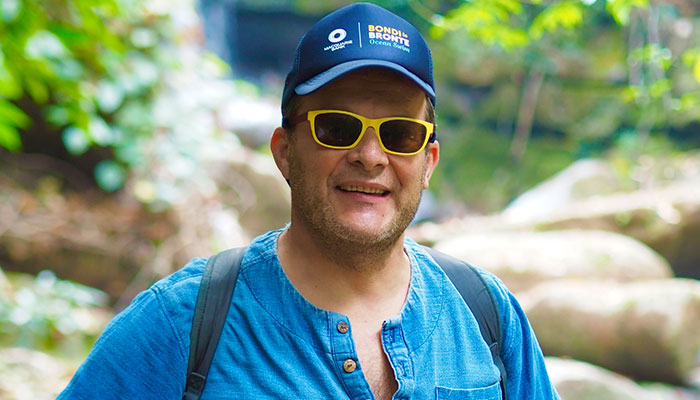New research from Macquarie University’s has the potential to change the way low back pain is managed, making effective interventions accessible to more people than ever before.

About four million Australians – and 800 million people worldwide – have low back pain, which is a leading cause of disability and reduced quality of life.
Recurrences of low back pain are very common, with seven in 10 people who recover from an episode going on to have a recurrence within a year.
Professor of Physiotherapy Mark Hancock and his research team have been investigating ways to shift the emphasis from treatment to prevention to improve the management of back pain, an approach that empowers individuals to manage their own health and reduces the cost to society and the healthcare system.
Far from the bed rest recommended for back pain in the past, current best practice includes the combination of exercise and education, both to treat current pain and to prevent future episodes.
While beneficial, some forms of exercise are not accessible or affordable to many people due to their high cost, complexity and need for supervision.
A simpler, more accessible method
The world-first WalkBack trial examined whether a program of walking combined with education could be effective in preventing recurrences of low back pain.
The trial followed 701 adults who had recently recovered from an episode of low back pain, randomly allocating participants to either an individualised walking program facilitated by a physiotherapist and six education sessions across six months, or to a no-intervention control group.
Walking is a low-cost, widely accessible and simple exercise that almost anyone can engage in, regardless of age, geographic location or socio-economic status.
The participants’ progress was then followed for between one and three years to collect information about any new recurrences of low back pain they experienced.
The researchers’ primary aim was to compare the two groups for the number of days before participants experienced a recurrence of back pain that impacted daily activities or required care from a healthcare provider.
They also evaluated the cost effectiveness of the intervention, including costs related to work absenteeism and healthcare services.
The findings have now been published in the latest edition of the prestigious international medical journal, The Lancet.
Longer pain-free periods
The paper’s senior author, Professor Hancock, says what they discovered could have a profound impact on how low back pain is managed.
“The intervention group had fewer occurrences of activity-limiting pain compared to the control group, and a longer average period before they had a recurrence, with a median of 208 days compared to 112 days,” Professor Hancock says.

Moving the dial: Professor Mark Hancock, pictured left, and lead author Dr Natasha Pocovi, pictured right, say their results could have an important impact on how back pain is managed in the future.
“The risk of having a recurrence that required seeking care was nearly halved in those in the intervention group.
“Walking is a low-cost, widely accessible and simple exercise that almost anyone can engage in, regardless of age, geographic location or socio-economic status.
“We don’t know exactly why walking is so good for preventing back pain, but it is likely to include the combination of gentle oscillatory movements, loading and strengthening the spinal structures and muscles, relaxation and stress relief, and the release of ‘feel-good’ endorphins.
“And of course, we also know that walking comes with many other health benefits, including cardiovascular health, improved bone density, maintenance of a healthy weight and improved mental health.”
Professor Hancock said the amount of walking each person completed was individualised based on a range of factors including their age, physical capacity, preferences and available time. Participants were given a rough guide to build up to 30 minutes, five times a week over a six-month period.
After three months, Professor Hancock said most of the people who took part were walking three to five days a week for an average of 130 minutes.
“You don’t need to be walking five or 10 kilometres every day to get these benefits,” Professor Hancock says.
A cost-effective option
The paper’s lead author, Postdoctoral Fellow Dr Natasha Pocovi, says in addition to providing participants with longer pain-free periods, they found the program was also cost effective.
“It not only improved people’s quality of life, but it reduced their need both to seek healthcare support and the amount of time taken off work by approximately half,” Dr Pocovi says.
“The exercise-based interventions to prevent back pain that have been explored previously are typically group-based and need close clinical supervision and expensive equipment, so they are much less accessible to the majority of patients.
“Our study has shown that this effective and accessible means of exercise has the potential to be successfully implemented on a much larger scale than other forms of exercise.”
To build on these findings, the team now hopes to explore how they can integrate the preventive approach into the routine care of patients who experience recurrent low back pain.
Case study: Rory’s path to reducing back pain
Rory Fagan joined the WalkBack trial in early 2021, seeking relief from a back injury sustained while playing rugby in his 20s.

Steps to success: Former rugby player and WalkBack participant Rory Fagan, pictured above, says his back pain has improved after taking part in the study.
He had been experiencing flare-ups once or twice a year that left him in severe pain and struggling to move for several days at a time.
In the three years that he has been walking three to four times a week, he has had just one episode of debilitating pain that lasted three or four days. And while he does still experience back pain once or twice a year, the intensity of the pain and the length of time it lasts have both dropped dramatically.
“Now instead of the pain being six or seven out of 10, it’s more like three out of 10, and it usually lasts less than 24 hours,” Mr Fagan says.
“The thing with back pain is that most people’s instinct is to not do anything, because even taking a step can send a jolt or spasm up your back. My attitude was always that I needed to rest and let it heal, but now I’ve learned that that’s the worst thing you can do.
“One of the most important things the program taught me is that you shouldn’t be afraid of the pain. Exercise is a path to reducing pain in the long term, so if you have a flare-up, you should keep doing what you can.”
When Mr Fagan started the trial, he was already an active surf life saver, volunteering with the Bronte Surf Life Saving Club.
Keen to share what he had learned through WalkBack, he helped start a walking group in the club’s Silver Salties program, which provides group exercise opportunities for older people.
It has proved popular and has been motivating both for him and for the group members.
“Exercise is just more fun in a group. It’s a rugby attitude – if you’re flagging, you grab a mate and it keeps you going.”
Top tips for walking and back pain
The results of the WalkBack study are based on individualised walking programs of varying distance and duration developed in collaboration with trained physiotherapists. If you would like to try walking as a way of managing recurrent back pain, follow these tips.
Build up gradually Begin with short walks – even just 10 minutes a few times a week – and gradually increase the duration and frequency. This is the best way to develop a habit and lowers the risk of overuse injuries.
Don’t be afraid of mild pain Some pain when starting a new activity is normal, so don’t give up. Walking will strengthen the structures in the back and the surrounding muscles over time, reducing the likelihood of recurrence.
Keep yourself accountable You could work with a physiotherapist or other clinician, but having a walking buddy can also be beneficial. Teaming up with a friend, family member, colleague or even a furry friend can help keep you on track when motivation is low.
Track your progress Identify your goals, such as increasing your daily step count or building stamina for longer walks. You could use a smartwatch or one of the many free exercise apps to follow your progress, or go analogue with a wall chart or notebook.
Don’t stop if you have a recurrence Recurrences of low back pain are still likely to occur, even with a good program of regular walking. If this happens, it is important to stay active, so reduce how much you are walking if you need to, but don’t stop.
is a Professor of Physiotherapy in the Department of Health Sciences at Macquarie University. He has more than 20 years of experience as a musculoskeletal physiotherapist in a clinical setting.
s a registered physiotherapist and Postdoctoral Fellow in the Department of Health Sciences at Macquarie University.







